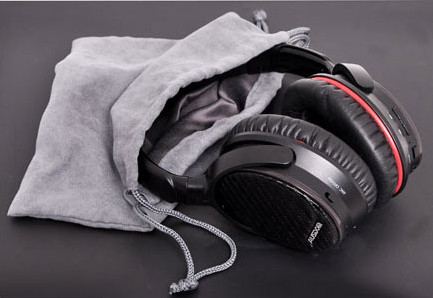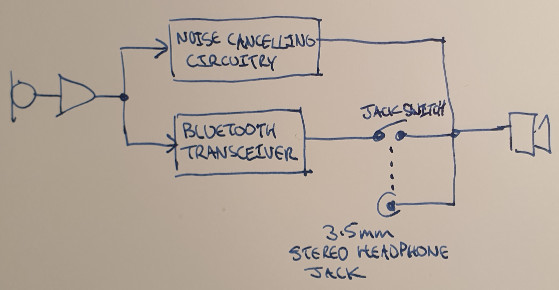
After being plagued by months of endless roadwork around where I live all night long, and listening to the racket created by the fridge all year round (being stuck indoors an awful lot the last couple of years with the covid plague running wild), and the crickets screaming outside (they're louder than they used to be thanks to increases in urban noise polution, evolution has favoured the loudest insects over the quieter ones), I thought I'd try out some noise-cancelling headsets. But to top off my noise-pollution annoyances, I also have tinnitus, with a continual 12 kHz whistle, and several other ones that come and go, so I've not been able to enjoy silence for many years. What that means, regarding noise-cancelling devices, was that I needed a headset that had some sort of audio playback feature as well as noise-cancelling.
So, after spotting some going relatively cheaply at Altronics, I bought these. Going for $99 AUD (reduced) they were affordable, and as well as offering a noise-cancelling feature, have two-way bluetooth audio (you can listen to sound files, you can have phone conversations). I don't expect too much, audio quality-wise, as Bluetooth is infamous for crushing the life out of music, but it's not too bad. Not to mention that cheap plastic headphones aren't well known for great audio quality, nor build quality (there's a number of sharp edges on this—that's something I'm really sick of with modern devices). Though I think if you're trying to listen to something in a noisy environment, to begin with, you were never going to get HiFi sound. Likewise for sound from places like YouTube, and highly compressed MP3s.
Firstly the noise-cancelling: Like all such systems, they work by sampling the ambient noise in the air, then try feeding the direct opposite of it to your ears, so that noise plus anti-noise cancel each other out. This isn't a perfect technology, and tends to need to be tuned to the specific problems (in design, rather than being user-adjustable), such as the rumble of traffic, the noises in an aeroplane, etc. And to some degree, all headphones muffle outside noise even when unplugged, so it's not like it's all going to be done with electronics. This does mean that you can try using some headphones you already have to filter out some ambient noise instead of buying expensive headsets, but the idea is that these headsets should filter out things even more.
There is an audible hiss from its amplifiers while it's working. I don't know if this is deliberate (adding some white noise to hide its operation), or if it could do with using better circuitry. It's doing a reasonably good job at reducing most of the things currently irritating me (roadwork noise, the fridge, the crickets), though not helping much with one of the neighbour's brainless dog's incessant barking. And it's doing well with other things I'm trying it out with (bathroom extraction fan, vacuum cleaner). It can never be perfect, but it's managing most things okay. These aren't the kind of headphones you can wear and still have a chat to someone with, all ambient noise around you goes through the noise-cancelling system. You'd have to take them off to talk to someone properly. Likewise, if you wanted to watch TV while wearing them, you'd need to pipe the TV sound through. So, onto the next bit:
Secondly, the audio input: The headset can be paired with any compatible device with Bluetooth, so you can listen to music, your TV, and you can make phone calls. And this works in isolation from the noise-cancelling feature. They each have separate on/off switches. Oddly, the audio-quality of the Bluetooth sound will change when you turn the noise-cancelling feature on or off. There seems more midrange and treble with noise-cancelling switched off, as well as the overall volume getting a bit louder (more about this below). The Bluetooth range was quite impressive, I could use it all around the house, with the signal going through several brick walls without any problems.
There's also a 3.5 mm headphone socket to pipe audio in from things without Bluetooth. It does work when the headset is switched off, so it's a passive feed in, and there's no volume control for it, you'll need to control volume level externally. It seems to be in parallel with the speakers, perhaps some kind of hardware mixing directly at the speakers. And just as with Bluetooth audio, switching the noise-cancelling feature on or off affects the audio quality. So I'm inclined to believe both halves of the audio are simply connected together at the speakers. This would appear to be confirmed by plugging the headphone socket into an external amplifier, as audio from the noise-cancelling circuit can be heard coming out of the 3.5 mm jack, as well as the earpieces acting like dynamic microphones. Plugging in the jack mutes the Bluetooth audio, but without disconnecting the Bluetooth connection, so you don't get three audio things working together.
Control-wise there's a sound-cancelling on/off slider switch on one ear, along with a status LED and a micro-USB charging port. On the other ear is another status LED, and there are three buttons which switch the Bluetooth reception on and off, and two volume controls. When held down for longer, the on/off switch inititates Bluetooth pairing, and the volume buttons act as track skipping. When the on/off switch is quickly tapped, it acts as an answer/hang-up switch for phone calls. All in all, it's quite straight-forward to use.
Comfort-wise, they're not too bad. They've got that pleather type of material (pretend leather) on the headband and earpads, though I've always preferred fabric-covered padding on headsets, I find my ears overheat terribly when sealed in. There not too bad, in that regards, seeing as they don't encircle your ear, but sit on top of it, but I still notice my ears getting too warm. And pleather always deteriorates with a few years, but it might be flexible vinyl, I can't tell. They're not heavy, nor do they clamp hard on your ears. You can even lean forward without them falling off your head, though they do start to slip out of place.
They came in a cardboard box with a soft carry bag. The bag's not going to protect the headset from anything more than dust and scratches, but it can help you keep all the bits together (a tiny instruction book, a USB charging cable, a stereo 3.5 mm jack-to-jack cable), and the box is moderately tough enough that it might survive being kept long-term. The earcups will rotate around so the headset can be stored flat, too take up less room, but they don't fold in into the headband.
Essentially, devices like this make you temporarily deafer, so they're not a wise idea to wear out in public. You're at greater risk of getting hit by a car, or mugged, if you can't hear things around you to alert you to danger. Listening to racket for hours on-end, whether that be noise pollution or music, is tiring and headache-inducing, so I've been trying subtle brown noise to mask the silence and take my mind off my tinnitus. Random noise is easy for the brain to ignore, and brown noise is less harsh than white noise, it's somewhat like the sound of rain when you're indoors. Unfortunately the 12 kHz squeal I've been enduring for the last few years is very loud, and trying to drown it out would cause further discomfort and hearing damage.
